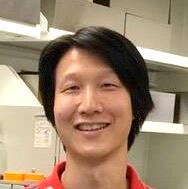
Trainee Spotlight: Yin-Ming Kuo, PhD
-

Yin-Ming Kuo, PhD
Research Associate
Dr. Andy Andrews’ lab
Fox Chase Cancer Center
[email protected]Biography
I grew up in Taipei, the capital city in the north of Taiwan. Prior to college, like many students, I spent my time cultivating hobbies, like playing basketball and collecting sports memorabilia, in lieu of studying. The one exception was anything and everything to do with chemistry, which captivated me—it seemed magical. In college, I immersed myself in understanding how chemicals impact the environment; I discovered that many synthetic chemicals had deleterious effects on our bodies and the environment. I completed my bachelor’s and master’s degrees in the Department of Nuclear Science (Environmental Science Division) at National Tsing Hua University in Taiwan. After which, I pursued an advanced degree with Dr. Inez Hua’s group at Purdue University to study the distribution and impact of emerging contaminants in the ecosystem.
Although I thoroughly enjoyed my projects that let me truly realize the power of analytical chemistry to accurately determine the quality of a study, I wanted to expand beyond environmental applications. Thus, after I completed my PhD in 2009, I moved to Dr. Jane Hill’s lab at the University of Vermont where I used ambient ionization mass spectrometry to study microbial metabolomics. In 2011, I brought my expertise to Fox Chase Cancer Center to work with Dr. Andrew Andrews where I developed mass spectrometry-based methods to study enzyme kinetics (in vitro) and epigenetics in yeast and mice models (in vivo). My career goal is to continue contributing my expertise in analytical chemistry to impactful research topics, like cancer biology.
Research Overview
Human diseases, including cancer and cardiovascular disease, are often associated with changes in epigenetic regulation, such as aberrant histone acetylation. In humans, histone acetylation is catalyzed by lysine acetyltransferases (KATs). However, how KATs select specific histone residues and how this selection is influenced during nucleosome assembly is poorly understood. To answer these questions, we focused on studying how different histone intermediates that precede nucleosome assembly affect the site specificity of Piccolo NuA4, an essential KAT complex in yeast. To this end, we investigated three different histone complexes, namely tetramer, tetrasome and nucleosome, and then quantitatively compared the site-specific preferences of Piccolo NuA4 on each complex. In order to effectively measure the large number of possible acetylation sites, we established a high throughput, a quantitative mass spectrometry-based method to determine the site-specific acetylation kinetics of Piccolo NuA4.
Prior to this study, we have investigated two other KATs, Gcn5 and Rtt109-Vps75, which have broad histone acetylation spectra and significantly differ in site-specific preferences of histone acetylation. In this study, we found that, similar to most KATs, Piccolo NuA4 acetylates multiple lysine residues. Importantly, Piccolo NuA4 favors nucleosome over the tetramer and tetrasome configurations, with the tetrasome being the least preferred. In addition to the configuration preferences, we found that Piccolo NuA4 acted on different subsets of lysines for each configuration. For example, we found that H3K14 is the preferential site of the tetramer and tetrasome configurations, while H4K12 is the highest favorable site for the nucleosome configuration. This data suggests that histone configuration directly influences the site specificity of Piccolo NuA4. These findings provide insight into how modulating chromatin configuration can influence epigenetic regulation.
Featured Publication
Yin-Ming Kuo, Ryan Henry, Song Tan, Jacques Côté, and Andrew Andrews. Site specificity analysis of Piccolo NuA4-mediated acetylation for different histone complexes. Biochem J. 2015 Dec 1;472(2):239-48.
